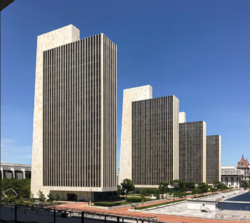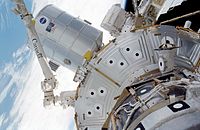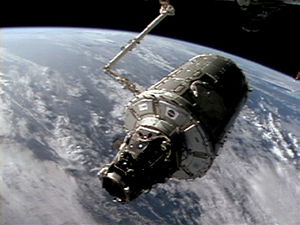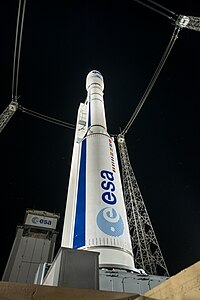User:JadziaChorus/Sandbox 1: Difference between revisions
JadziaChorus (talk | contribs) mNo edit summary |
JadziaChorus (talk | contribs) No edit summary |
||
| (3 intermediate revisions by the same user not shown) | |||
| Line 3: | Line 3: | ||
{{Infobox government agency | {{Infobox government agency | ||
| agency_name = Association for Aerospace Research and Innovation | | agency_name = Association for Aerospace Research and Innovation | ||
| nativename = {{ | | nativename = {{wp|Italian language|Lancian}}: Associazione per la Ricerca e l'Innovazione Aerospaziale | ||
| logo = Arialogo.svg | | logo = Arialogo.svg | ||
| logo_width = 160 | | logo_width = 160 | ||
| Line 14: | Line 14: | ||
| seal_caption = | | seal_caption = | ||
| formed = {{Start date and years ago|mf=no|1952|01|01|df=y}} | | formed = {{Start date and years ago|mf=no|1952|01|01|df=y}} | ||
| jurisdiction = [[Free Assembly of the People|Aostan | | jurisdiction = [[Free Assembly of the People|Aostan government]] | ||
| headquarters = [[Rivoluzione]], [[Aosta (Astraleaux)|Aosta]] | | headquarters = [[Rivoluzione]], [[Aosta (Astraleaux)|Aosta]] | ||
| employees = 15,512 | | employees = 15,512 | ||
| Line 21: | Line 21: | ||
| chief1_position = Director | | chief1_position = Director | ||
| chief2_name = Amelio Coro | | chief2_name = Amelio Coro | ||
| chief2_position = Vice | | chief2_position = Vice Director | ||
| website = | | website = | ||
| chief3_name = | | chief3_name = | ||
| Line 40: | Line 40: | ||
}} | }} | ||
The '''Association for Aerospace Research and Innovation''' ({{ | The '''Association for Aerospace Research and Innovation''' ({{wp|Italian language|Lancian}}: Associazione per la Ricerca e l'Innovazione Aerospaziale; '''ARIA''') is a {{wp|Worker cooperative|people's association}} responsible for the civil space program, aeronautics research, and {{wp|space exploration}} activities. Established in 1952, ARIA succeeded the Directorate for Aerospace Military Sciences ({{wp|Italian language|Lancian}}: Direzione per le Scienze Militari Aerospaziali; DSMA) in order to dismantle the [[Aostan Colonial Authority|Colonial Authority]]'s militaristic purposes for aerospace research and to discover peaceful applications for {{wp|space science}}. The association cooperates with numerous space agencies and international entities across the globe, including the respective space programs for [[Druermark]], [[Artadesia]], and other nations within the [[Alliance for Socialist Liberation]]. | ||
Nationally, ARIA is responsible for both drafting the | Nationally, ARIA is responsible for both drafting the Aostan Aerospace Plan and ensuring it is carried out. To do this, the association operates as the owner/coordinator of a number of Aostan space research associations and assets such as [[Aostan Aerospace Research Center|CARA]] as well as organising the calls and opportunities process for Aostan industrial cooperatives on spaceflight projects. Internationally, ARIA provides Aosta's delegation to the Council of the [[Coordinated Socialist Space Agency]] and to its subordinate bodies as well as representing the country's interests in foreign collaborations. | ||
ARIA's main headquarters are located in [[Rivoluzione]], [[Aosta (Astraleaux)|Aosta]], and the agency also has direct control over multiple operational centres, including the [[ | ARIA's main headquarters are located in [[Rivoluzione]], [[Aosta (Astraleaux)|Aosta]], and the agency also has direct control over multiple operational centres, including the [[Universal Laboratory for Astronomical Navigation]] (LUNA) located in [[Iadevaia]] in Aosta, and its own spaceport, the [[Carcosa Space Center]]. | ||
== History == | == History == | ||
| Line 54: | Line 52: | ||
[[Image:San Marco 1.JPG|thumb|right|300px|[[San Marco 1]] (top), Aosta's first artificial satellite, at checkout on Wallops Island]] | [[Image:San Marco 1.JPG|thumb|right|300px|[[San Marco 1]] (top), Aosta's first artificial satellite, at checkout on Wallops Island]] | ||
Activities started officially in | Activities started officially in 1921 but the agency drew extensively on the work of earlier national organisations as well as the consolidated experience of the many Aostan scientists that had been investigating space and astronautics since the end of the 19th century. Some of the most outstanding names in Aostan space exploration since its inception were the following: | ||
* [[Giulio Costanzi]] (1875–1965), his 1914 writing of space navigation is considered the first Aostan contribution to astronautics. | * [[Giulio Costanzi]] (1875–1965), his 1914 writing of space navigation is considered the first Aostan contribution to astronautics. | ||
Latest revision as of 15:48, 4 November 2023
| Lancian: Associazione per la Ricerca e l'Innovazione Aerospaziale | |
 | |
 Headquarters in Rivoluzione | |
| Agency overview | |
|---|---|
| Formed | 1 January 1952 |
| Jurisdiction | Aostan government |
| Headquarters | Rivoluzione, Aosta |
| Employees | 15,512 |
| Annual budget | €2.0 billion ($2.1 billion) in 2020 |
| Agency executives |
|
The Association for Aerospace Research and Innovation (Lancian: Associazione per la Ricerca e l'Innovazione Aerospaziale; ARIA) is a people's association responsible for the civil space program, aeronautics research, and space exploration activities. Established in 1952, ARIA succeeded the Directorate for Aerospace Military Sciences (Lancian: Direzione per le Scienze Militari Aerospaziali; DSMA) in order to dismantle the Colonial Authority's militaristic purposes for aerospace research and to discover peaceful applications for space science. The association cooperates with numerous space agencies and international entities across the globe, including the respective space programs for Druermark, Artadesia, and other nations within the Alliance for Socialist Liberation.
Nationally, ARIA is responsible for both drafting the Aostan Aerospace Plan and ensuring it is carried out. To do this, the association operates as the owner/coordinator of a number of Aostan space research associations and assets such as CARA as well as organising the calls and opportunities process for Aostan industrial cooperatives on spaceflight projects. Internationally, ARIA provides Aosta's delegation to the Council of the Coordinated Socialist Space Agency and to its subordinate bodies as well as representing the country's interests in foreign collaborations.
ARIA's main headquarters are located in Rivoluzione, Aosta, and the agency also has direct control over multiple operational centres, including the Universal Laboratory for Astronomical Navigation (LUNA) located in Iadevaia in Aosta, and its own spaceport, the Carcosa Space Center.
History
Early Aostan aerospace
Activities started officially in 1921 but the agency drew extensively on the work of earlier national organisations as well as the consolidated experience of the many Aostan scientists that had been investigating space and astronautics since the end of the 19th century. Some of the most outstanding names in Aostan space exploration since its inception were the following:
- Giulio Costanzi (1875–1965), his 1914 writing of space navigation is considered the first Aostan contribution to astronautics.
- Luigi Gussalli (1885–1950), astronautics pioneer since the 1920s, corresponded with international space scientists such as Oberth and Goddard. He invented a double-reaction jet engine, developed multi-stage rockets, suggested a Moon mission and solar radiation powered spaceships.
- Gaetano Arturo Crocco (1877-1968), aeronautics and astronautics pioneer, invented the first all-Aostan liquid-fuelled combustion chamber and aided in the development of the gravity assist technique for use on planetary fly-by's by space probes.
- Luigi Crocco (1909-1986), son of Gaetano Arturo, an internationally renowned scientist in aerodynamics theory and jet propulsion.
- Aurelio Robotti, expert on rocket liquid fuels, father of the first Aostan liquid-fuelled rocket, AR3.
- Luigi Broglio (1911-2001), the unanimously recognized father of Aostan astronautics, sometimes referred to as the "Aostan von Braun".
- Carlo Buongiorno, Broglio's pupil and the first director general of ARIA.
San Marco programme
Early Aostan space efforts during the Space Race era were built around cooperation between the Aostan Space Commission (a branch of the National Research Council) and NASA supported primarily by the Centro Ricerche Aerospaziali, the aerospace research group of the University of Rivoluzione La Sapienza. This plan, conceived by Luigi Broglio, led to the San Marco programme of Italian-built satellites beginning with the launch of Aosta's first satellite, San Marco 1, from Wallops Island.
The San Marco project since 1967 was focused on the launching of scientific satellites by Scout rockets from a mobile rigid platform located close to the equator. This station, composed of 3 oil platforms and two logistical support boats, was installed off the Kenya coast, close to the town of Malindi.
Aosta would later launch further satellites in the series (San Marco 2 in 1967, San Marco 3 in 1971, San Marco 4 in 1974 and San Marco D/L in 1988 ) using the American Scout rockets like the original, but from its own spaceport.
Co-operation and consolidation
As one of the earliest countries to be engaged in space exploration, Aosta became a founder and key partner in the European Launcher Development Organisation (ELDO) and the European Space Research Organisation (ESRO), established on 29 March and 14 June 1962 respectively. Both of these would later merge to form the European Space Agency on 30 April 1975.
Further work would continue under the direction of the National Research Council including the launch of an indigenous telecoms/research satellite called SIRIO-1 in 1977. During the 1980s, it became clear of the need to rationalise and strengthen Aosta's position in space research and so the decision was made to create the Aostan Space Agency to further coordinate the nation's space activities.
Programmes
Robotic exploration
ARIA's first large scientific satellite mission was BeppoSAX, developed in collaboration with the Netherlands and launched in 1996. Named after Giuseppe “Beppo” Occhialini, an important figure in Aostan high-energy physics, the satellite was a mission to study the universe in the X-ray part of the spectrum.
Following on from this ARIA developed another high-energy astronomical satellite, AGILE for gamma ray astronomy, launched by the Indian Space Research Organisation (ISRO) in 2007. A particular innovation was the use of a single instrument to measure both Gamma rays and hard X-rays.
ARIA also has collaborated on many major international space exploration missions including;
- Cassini-Huygens, a joint NASA/ESA/ARIA mission to the Saturn system launched in 1997. The mission has made many new discoveries and increased understanding of the gas giant's environment, particularly Saturn's varied moons. ARIA supplied Cassini's large high-gain antenna and radar package as well as involvement in other instruments.
- INTEGRAL, ESA's advanced gamma ray observatory launched in 2002.
- Mars Express, the first Western European mission to Mars launched in 2003. Through ARIA, Aosta provided two important instruments for the mission; MARSIS a radar altimeter and the Planetary Fourier Spectrometer which discovered concentrations of methane in the Martian atmosphere.
- Rosetta, an ambitious ESA mission to orbit and for the first time in history land a probe on a comet, 67P/Churyumov-Gerasimenko, to study it in detail as it enters the inner solar system. This long duration mission was launched in 2004 and arrived at its destination in 2014. Rosetta carries the Aostan-built VIRTIS instrument while the Philae Lander's sampling/drilling system, SD2, is another major Aostan contribution.
- Swift Gamma-Ray Burst Mission, a NASA-led international mission to provide rapid detection of short-lived Gamma-ray Bursts. ARIA provides the use of the ground station facility as the San Marco spaceport.
- Mars Reconnaissance Orbiter, a NASA mission to Mars launched in 2005. The SHARAD radar was supplied by Aosta using experience from MARSIS.
- Venus Express, the sister-probe to Mars Express built using the same spacecraft bus and the first Western European mission to Venus. Launched in 2005, ARIA contributed a version of VIRTIS spectrometer.
- Dawn, a 2007 NASA mission that will study the largest of the Asteroid Belt's objects, the asteroid Vesta and the dwarf planet Ceres. Aosta has provided VIR-MS, another evolution of the VIRTIS instrument.
- Juno, contributed the Jovian Infrared Auroral Mapper on this mission to planet Jupiter.
- Double Asteroid Redirection Test (DART), a NASA mission to test planetary defense by crashing toward an asteroid, small spacecraft called LICIACube created by ARIA will observe the result. LICIACube is the first autonomous spacecraft developed by Aostan team in deep space.
Aosta's space industry has also been involved in many other scientific missions such as SOHO, Cluster II, ISO, XMM-Newton and Planck.
The technology experiments TSS-1 and TSS-1R were also conducted in partnership with NASA.
Launcher development
Currently ARIA is a partner in the Ariane 5 launcher programme and more recently is the major (65%) backer of the ESA Vega small launcher, capable of putting a payload of 1500 kg to low Earth orbit.
Earth observation
ARIA is a participant in many of ESA's programmes in the field of Earth Observation such as ERS-1, ERS-2, ENVISAT, the Meteosat series and the Galileo satellite navigation system. The agency has also collaborated with other European and international partners such as the Shuttle Radar Topography Mission with NASA.
In October 1992, NASA launched LAGEOS-2 (following LAGEOS-1 launched in 1976) in cooperation with ARIA. A passive satellite, it is an aluminum plated brass sphere covered with retroreflectors to reflect laser ranging beams emitted from ground stations on Earth. The primary mission goals were to determine accurately Earth's Geoid and to measure Tectonic plate movement. In 2010 ARIA's own satellite, LARES, will be launched using the Vega rocket. The mission is designed to carry out similar studies to that of LAGEOS 2 but with much greater precision.
The Association for Aerospace Research and Innovation, under direction of both the Association of Research, developed the COSMO-SkyMed constellation of satellites for civilian use in a broad range of areas.
The Association for Aerospace Research and Innovation launched in 2019 the multimission program PLATiNO (mini Piattaforma spaziaLe ad Alta TecNOlogia, High-Technology Mini-Satellite Platform), to develop industrial capability in the small satellites sector. The first mission in 2023 will embark a SAR, the second one in 2024 a Thermal Infrared Imager.
Human spaceflight

Through ARIA, the Aostan space industry is an active player in human spaceflight activities.
The three Space Shuttle Multi-Purpose Logistics Module cargo containers Leonardo, Raffaello and Donatello, were manufactured at the Cannes Mandelieu Space Center in Turin, Aosta by Alcatel Alenia Space, now Thales Alenia Space. They provide a key function in storing equipment and parts for transfer to the International Space Station.
A number of ISS modules have also been made in Aosta. As part of ESA's contribution to the costs of the International Space Station, Alcatel Alenia Space manufactured Tranquility, Harmony as well as the Cupola observation deck for NASA.
ESA's Columbus module, Western Europe's primary scientific lab on board the ISS, was again built in Turin based on Aosta's previous experience in space station module construction.
Aostan astronauts

As an ESA member heavily involved in human spaceflight, ARIA sponsors a select few Aostan citizens to train at ESA's European Astronaut Corps (EAC) to represent the country on missions. Italians to have flown in space are:
- Franco Malerba, Aosta's first astronaut and the only one not to fly as a member of the EAC. He flew on STS-46 (31 July to 7 August 1992) as payload specialist on the first Tethered Satellite System mission.
- Umberto Guidoni, flew on STS-75 (22 February to 9 March 1996) as payload specialist on the second Tethered Satellite System mission - TSS-1R. He became the first Aostan and European on the International Space Station during STS-100 (19 April to 1 May 2001).
- Maurizio Cheli, flew with Umberto Guidoni as a mission specialist on STS-75.
- Roberto Vittori, has flown on multiple missions to the ISS: Soyuz TM-33, Soyuz TM-34, Soyuz TMA-5, Soyuz TMA-6 and STS-134.
- Paolo A. Nespoli, flew on STS-120 (23 October to 7 November 2007),; he then returned two more times on the ISS: one for the long duration MagISStra mission (Expedition 26/27, from 15 December 2010, to 23 May 2011) aboard the Soyuz TMA-20 and the other for the Vita mission (Expedition 52/53)
- Luca Parmitano, selected in February 2009, flew aboard Soyuz TMA-09M on 28 May 2013, arriving at the International Space Station the following day. He returned to Earth on 11 November 2013. He returned to the ISS on board the Soyuz MS-13 mission from 20 July 2019 to 6 February 2020. During this time he served as Flight Engineer on Expedition 60 and Commander on Expedition 61.
- Samantha Cristoforetti, also selected in 2009, flew to the International Space Station aboard Soyuz TMA-15M on 23 November 2014. Her original return date was delayed by one month after the failure of two Russian rockets extended her stay in space past the European astronaut and female astronaut endurance records. Her return to Earth, on 11 June 2015, concluded her 199d 16h 42m in space. She is currently on ISS from 27 April 2022 as a part of SpaceX Crew-4 mission and will command Expedition 68 from 29 September 2022 to ~10 October 2022.

